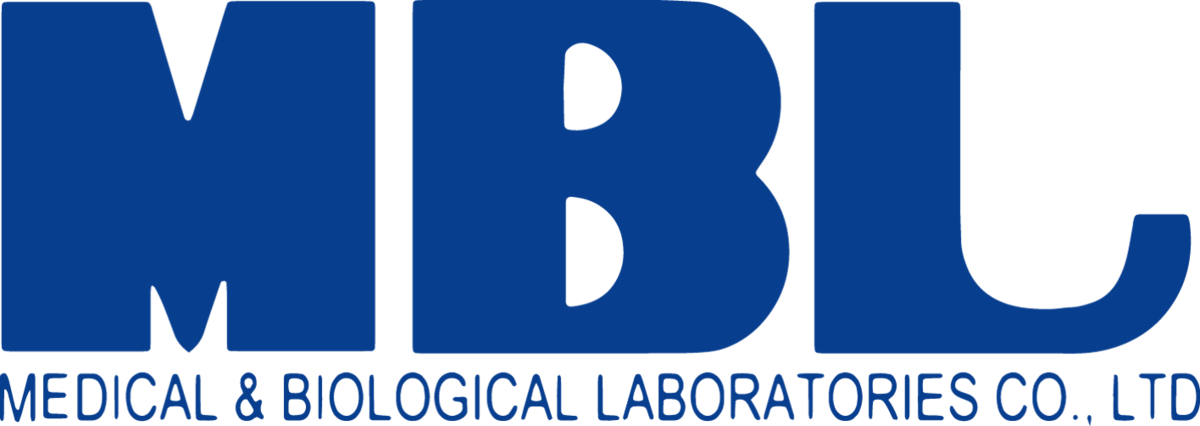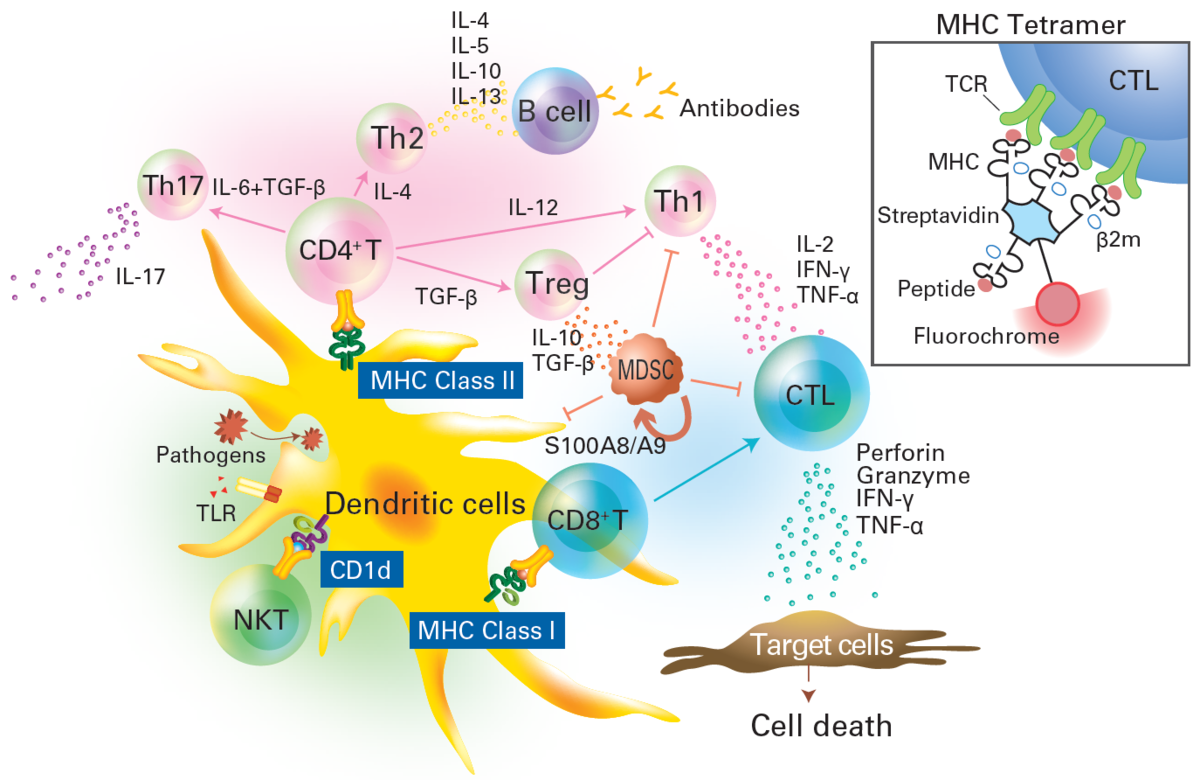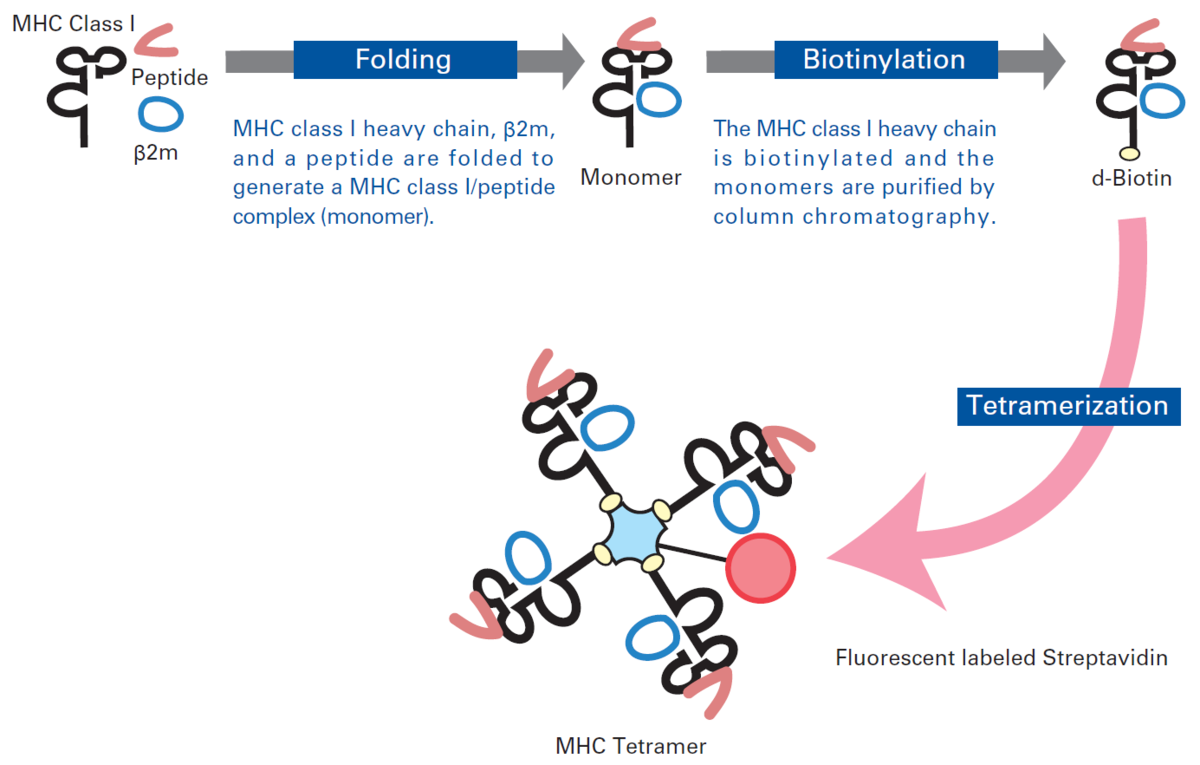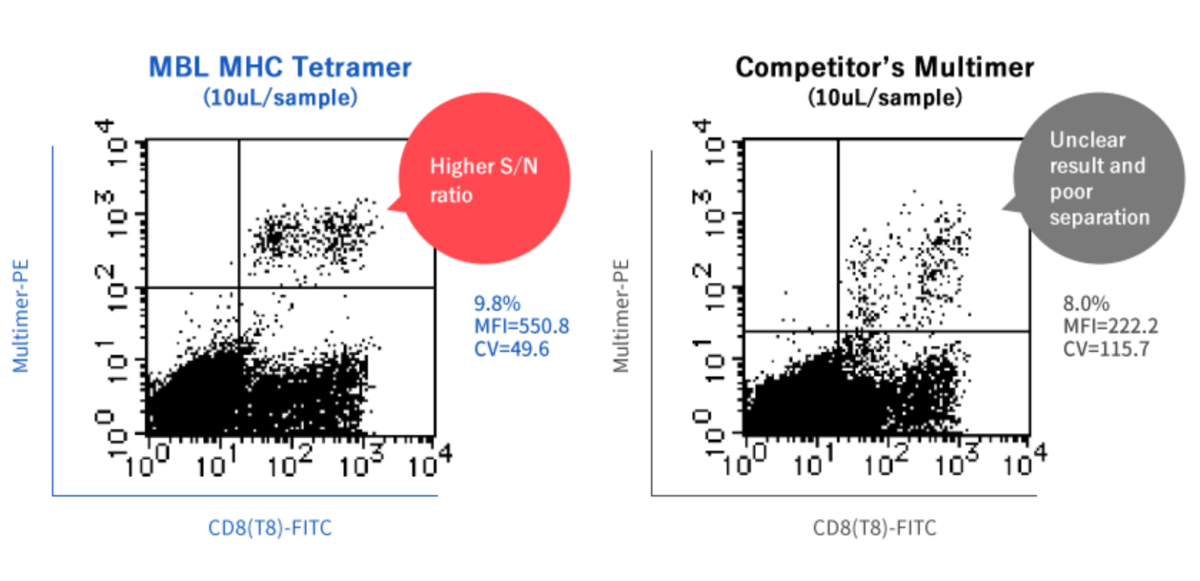MHC tetramers are immune monitoring reagents based on the Major Histocompatibility Complex (MHC) Class I/peptide complexes developed by Altman et al (Science 1996, 274: 94−96). In this seminal publication, tetrameric complexes of MHC bound to peptide were utilized as probes for the detection and quantitation of antigen-specific cytotoxic T-lymphocytes (CTL). Over the last 25 years, these reagents have become essential tools for measuring T-cell responses in basic research, clinical development, and immune monitoring in the fields of infectious disease, cancer vaccine therapy, cellular immunotherapy, transplantation tolerance, and autoimmune disease.
The role of MHC in the immune system is to stimulate an immune response against cells which have ingested infectious microorganisms. Found on the surface of antigen-presenting cells such as macrophages and dendritic cells, they bind the digested peptide fragments of infectious particles within the cell, and then present them on the cell surface. The presented MHC/peptide complexes are detected by T-cell receptors (TCR) located on the surface of T-lymphocytes leading to an immune response and eventual cell death. MHC complexes are divided into Class I and Class II, where CD8+ T-cells recognize Class I MHC molecules and CD4+ T-cells recognize Class II MHC molecules. The CD4 and CD8 glycoproteins act as coreceptors stabilising the interaction allowing the TCR to stay bound to the MHC complex, resulting in downstream effects which differ depending on the T-cell type. CD8+ T-cells, also known as cytotoxic T-lymphocytes, initiate programmed cell death. While CD4+ T-cells, also known as helper T-cells, release cytokines and aid the activity of other immune cells.
MBL tetramer synthesis
Monomeric MHC binds T-cell receptor with too low affinity to be successfully used as a detection tool. However, tetramerization increases the avidity of MHC/peptide complex binding to TCR, enabling researchers to precisely measure targeted T-cell responses. Tetramerization is achieved via biotinylation of the MHC/peptide monomers. On addition of streptavidin, which has four biotin binding sites, a tetramer forms allowing the complex to maintain stable binding to multiple TCR. Bound to the streptavidin, phycoerythrin (PE), allophycocyanin (APC), or Brilliant Violet™ 421 (BV421) fluorophores are available for detection of antigen-specific T-cells by flow cytometry or fluorescence microscopy. In addition to MHC Class I human, mouse, rhesus macaque, mauritian cynomolgus macaque, chicken and human-mouse chimera alleles are available. Also offered are various Class II human and mouse alleles, as well as CD1d and MR1 tetramers.
Advantages over competitors
The major histocompatibility complex in humans is also termed the human leukocyte antigen (HLA) system. MBL International has incorporated a patented mutation of the α3 domain in their HLA Class I tetramers (human and macaque only), increasing specificity by minimising unwanted binding to CD8 molecules. Non-mutated tetramers can bind CTLs via CD8, independent of TCR, leading to detection of antigen-non-specific CTLs (false positives) and poor resolution of true positives. MBLI tetramers show greater specificity and target separation compared to their competitors with a higher signal to noise ratio in flow cytometry. An optimised mixing ratio of raw materials dramatically improves tetramer synthesis efficiency and achieves high sensitivity. Whereas competitor’s multimers can show low reproducibility due to difficulties in quantity and quality control of the number of MHC molecules when producing multimers.
QuickSwitch™ Custom Tetramer Kits
MBLI’s proprietary QuickSwitch™ technology allows researchers to purchase human Class I and Class II, and mouse Class I MHC tetramer kits to produce their own custom tetramers by peptide exchange. These kits are supplied with a tetramer bound with an irrelevant peptide. After addition of a peptide exchange factor and peptide of interest, peptide exchange will occur if there is sufficient binding affinity between the peptide and MHC molecule. By using the QUANT kit, the amount of exchange that occurred can be quantified, thereby gathering binding affinity information for the MHC/peptide complex. The whole process takes only 8 hours with under 2 hours hands on time, enabling fast and efficient screening of peptide-MHC affinities, production of custom MHC tetramers, and many other applications.
Further information
For more Information on MHC tetramers and their staining method, download the guide.
Products
Available from LubioScience, MBL International has thousands of MHC allele and sequence combinations available and offer custom tetramer production should your tetramer of choice not be listed.
Supplier

MBL International Corporation (MBLI)
MBL International Corporation - immunology, immuno-oncology and autoimmune diseases. MHC tetramers & monomers, antibodies, in vivo grade antibody controls.




